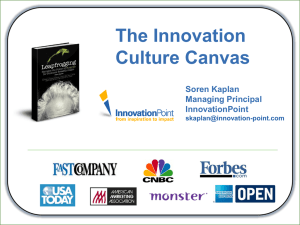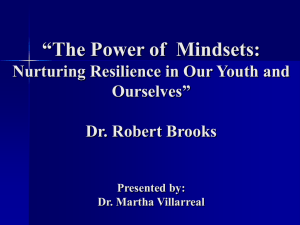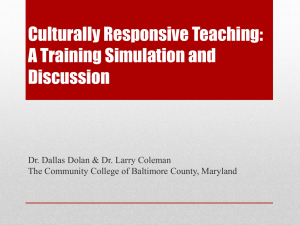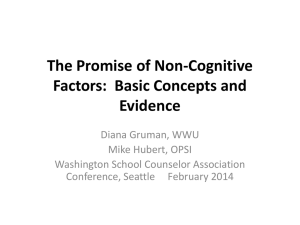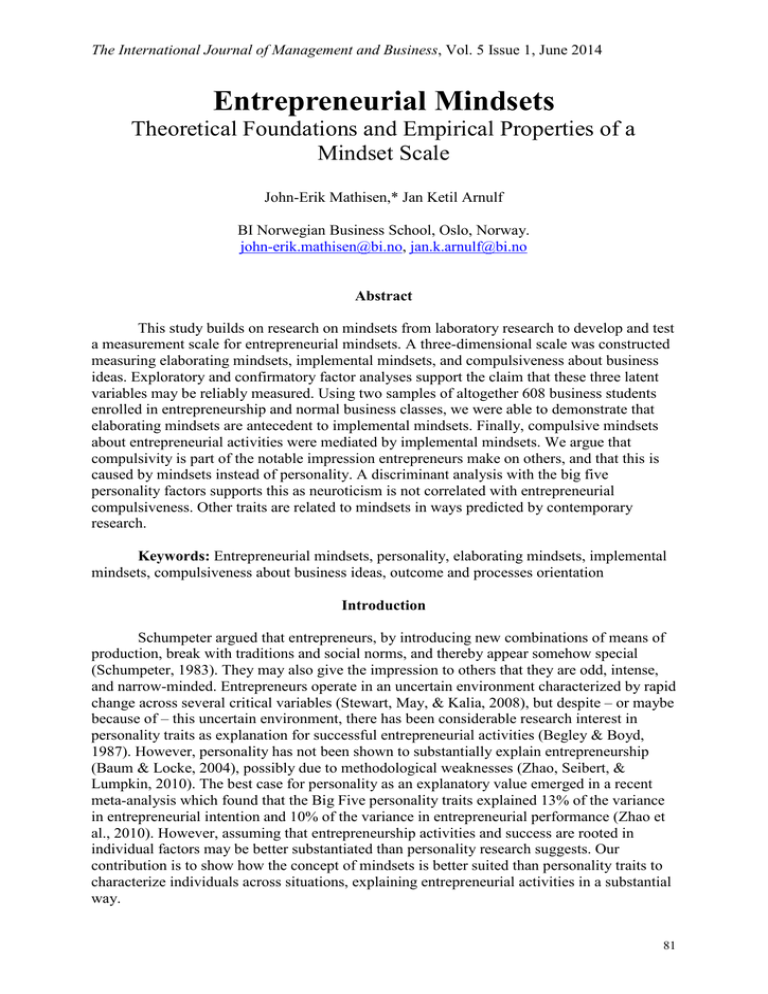
The International Journal of Management and Business, Vol. 5 Issue 1, June 2014
Entrepreneurial Mindsets
Theoretical Foundations and Empirical Properties of a
Mindset Scale
John-Erik Mathisen,* Jan Ketil Arnulf
BI Norwegian Business School, Oslo, Norway.
john-erik.mathisen@bi.no, jan.k.arnulf@bi.no
Abstract
This study builds on research on mindsets from laboratory research to develop and test
a measurement scale for entrepreneurial mindsets. A three-dimensional scale was constructed
measuring elaborating mindsets, implemental mindsets, and compulsiveness about business
ideas. Exploratory and confirmatory factor analyses support the claim that these three latent
variables may be reliably measured. Using two samples of altogether 608 business students
enrolled in entrepreneurship and normal business classes, we were able to demonstrate that
elaborating mindsets are antecedent to implemental mindsets. Finally, compulsive mindsets
about entrepreneurial activities were mediated by implemental mindsets. We argue that
compulsivity is part of the notable impression entrepreneurs make on others, and that this is
caused by mindsets instead of personality. A discriminant analysis with the big five
personality factors supports this as neuroticism is not correlated with entrepreneurial
compulsiveness. Other traits are related to mindsets in ways predicted by contemporary
research.
Keywords: Entrepreneurial mindsets, personality, elaborating mindsets, implemental
mindsets, compulsiveness about business ideas, outcome and processes orientation
Introduction
Schumpeter argued that entrepreneurs, by introducing new combinations of means of
production, break with traditions and social norms, and thereby appear somehow special
(Schumpeter, 1983). They may also give the impression to others that they are odd, intense,
and narrow-minded. Entrepreneurs operate in an uncertain environment characterized by rapid
change across several critical variables (Stewart, May, & Kalia, 2008), but despite – or maybe
because of – this uncertain environment, there has been considerable research interest in
personality traits as explanation for successful entrepreneurial activities (Begley & Boyd,
1987). However, personality has not been shown to substantially explain entrepreneurship
(Baum & Locke, 2004), possibly due to methodological weaknesses (Zhao, Seibert, &
Lumpkin, 2010). The best case for personality as an explanatory value emerged in a recent
meta-analysis which found that the Big Five personality traits explained 13% of the variance
in entrepreneurial intention and 10% of the variance in entrepreneurial performance (Zhao et
al., 2010). However, assuming that entrepreneurship activities and success are rooted in
individual factors may be better substantiated than personality research suggests. Our
contribution is to show how the concept of mindsets is better suited than personality traits to
characterize individuals across situations, explaining entrepreneurial activities in a substantial
way.
81
The International Journal of Management and Business, Vol. 5 Issue 1, June 2014
Personality traits are, by definition, assumed to be invariant, requiring high test-retest
reliability and inter-rater reliability. Such methodological demands exclude many personrelated characteristics of more transient character, leaving only very general dimensions (Chia
& Holt, 2008). Striking characteristics of successful entrepreneurs need not necessarily
comply with psychometric requirements of test, but may still appear as persistently stable and
unique enough to link success (or failure) to individual characteristics (Lent & Brown, 2006).
Given the volatility of the entrepreneurial business environment and the assumed stability of
personality traits, a more perception-based explanation of entrepreneurs could expand our
understanding of the entrepreneurial process (Krueger, Reilly, & Carsrud, 2000). Certain
aspects of entrepreneurs’ cognition may cause them to act differently from other people (R. A.
Baron, 2004). Perceived change in the entrepreneurial business environment has been shown
to incite entrepreneurs to search for new opportunities (Stewart et al., 2008). Earlier
publications have called for research on the interaction between the external and internal
environment and their effect on how entrepreneurs conceive adaptable strategies (e.g., Yang
& Chandra, 2009). Mindsets appear to be a promising construct in this respect. Mindsets may
be described as malleable strategies that evolve and change in concert with the individual’s
interaction and experience with their environment (Gollwitzer, 1990). Previous research has
conceptualized entrepreneurial mindsets as one single dimension, applying demographic data
(Sarasvathy, Simon, & Lave, 1998) or qualitative data (Navis, 2009). More than a century of
laboratory research in psychology has shown that forming mindsets is a process ranging from
consciously accepting a task through automatic election of the task to perceived situational
cues (Gollwitzer, 1990; Humphrey, 1951). Our research question is whether it is possible to
create a survey of entrepreneurial mindsets based on experimental research that will show
acceptable psychometric properties and explain entrepreneurial activities over and above
common personality trait measurements.
To our knowledge, no one has developed a scale that quantitatively measures the
intensity of unique mindsets associated with different stages in the process of becoming
engaged in entrepreneurial activities. Such a scale may offer the opportunity to measure
entrepreneurial mindsets more systematically and to explore a broader content of
entrepreneurial mindsets. Additionally, this conceptualization may be used to explain how
entrepreneurial mindsets develop in teaching and in practice, and to increase our
understanding of the relationship between entrepreneurial mindsets and entrepreneurial
activities. Drawing on experimental research on mindsets, we attempt to construct a surveybased approach that may be less obtrusive than laboratory experiments, but that still applies
this knowledge to actual real-life entrepreneurial activities.
Theory
The term “entrepreneurship” appears to be hard to define in a precise and
unambiguous manner (Sorenson & Stuart, 2008). Increasingly, researchers have turned to
opportunity recognition as a core activity in the entrepreneurial process (Short, Ketchen,
Shook, & Ireland, 2010). Some researchers have also defined entrepreneurship as a pattern
recognition activity (R. A. Baron & Ensley, 2006) and found mindset or mental frames as
key features in the opportunity recognition process (Munoz, Mosey, & Binks, 2011).
Mindsets are conceived as “general cognitive operations with distinct features that
facilitate a given task ” (Torelli & Kaikati, 2009, p. 233). The concept of mindset goes back to
the Würzburg School of psychological research which was founded by Oswald Külpe at the
end of the 19th century. The Würzburgers were pioneers in the experimental study of human
motivation and higher mental functioning. Their experiments showed that most human
thinking happens without images (imageless thoughts), and that most of it also occurs outside
82
The International Journal of Management and Business, Vol. 5 Issue 1, June 2014
of our awareness (Benjafield, 1996; Gollwitzer, 1990; Humphrey, 1951). They named this
new category of human thinking “Bewusstseinslage,” literally a “state of mind,” which later
was translated into the concept of mindsets (“Einstellung”) (Humphrey, 1951). For a review
of the contribution of the Würzburger school, see Gibson(1941) and Humphrey (1951).
Külpe studied what he called “abstractions.” One experiment presented four nonsense
syllables to subjects for 0.125 seconds. The syllables were colored differently and arranged to
form various figures. The subjects watching them were given different instructions in advance
– an instruction to observe the number of letters, the color, their approximate location, the
figure formed by the letter, the letters themselves with their approximate location or no
instruction at all (control condition). The results showed that subjects would single out the
features related to their tasks, and unimportant features were rejected from attention. For
example, with the task of observing the number of letters, the subjects may be totally unable
to report on color and may deny that color has been experienced at all. This is the original
meaning of the term “mindset;” the brain is “set” to perceive the world according to
predefined criteria (Humphrey, 1951).
The process whereby the mind gets “set” was studied in more detail in Külpe’s
laboratory. Watt used the word “Aufgabe” (task) when he investigated the relationships
between the task itself and the ensuing mindset, preparing the individual for proper task
completion (Humphrey, 1951). His colleague, Ach, observed that the tasks would gradually
disappear from consciousness in subjects who participated in his reaction studies. With
increased practice, the awareness that a reaction should take place waned when a specific
stimulus was present. The task kept being completed even if there was no awareness of it. The
waiting period for the stimuli to appear was also reported by the subjects as becoming
impalpable and subjects had no phenomenological awareness of inner speech at the time of
study. Ach argued that the original purpose is forgotten and the appearance of the stimulus
automatically activated the prescribed conduct (Humphrey, 1951).
In this way, mindsets are conceived as automated processing of stimuli, possibly
related to stable individual behavioral dispositions, but malleable, and as shown
experimentally, a product of experience (Humphrey, 1951). The word “set” in mindset is,
strictly speaking, a verb, describing how someone is perceptually prepared or “set” to detect
and respond to a given situation (Cohen-Kdoshay & Meiran, 2007). Mental set means that
attention sets the mind to respond in a certain manner to particular aspects of stimulation. In
turn, stimulus presentation releases the automatic process comprising the set (Cohen-Kdoshay
& Meiran, 2007). The object of a mindset is therefore a type of pattern recognition,
reminiscent of the concept “stimulus” in behavioristic terminology (Skinner, 1978). The
difference is, however, that the concept “mindset” not only describes a response to a given
stimulus, but a sensitivity to environmental patterns that imposes percepts on stimuli in an
automatic effortless manner.
The Würzburg tradition was largely focused on experimental laboratory research.
Obtaining experimental control is harder in applied settings such as classrooms and workplace
environments. Looking for ways to develop and empirically test a less obtrusive measure such
as an entrepreneurial mindset scale, we turned to the works of Gollwitzer (1990). Combining
the Würzburg tradition with Kurt Lewins’ distinction between goal setting and goal striving,
Gollwitzer argued that goal-oriented behavior is made up of different phases labeled
“deliberating,” “planning,” “acting,” and “evaluating.” Each phase is characterized by a task
that has to be solved, and the overall success of an activity will be dependent on the success
of any one of these phases. Gollwitzer’s approach is reminiscent of, but more detailed than
Dweck’s research on mindsets in goal orientation (Dweck, 2006). We use the concept
“mindsets” to explore how people arrive at their chosen goal and the applied strategies for
goal achievement. Becoming engaged in each of the tasks produces a mindset facilitating
83
The International Journal of Management and Business, Vol. 5 Issue 1, June 2014
task completion – but like all mindsets, these become automated and happen without
awareness. We chose to identify the various phases with two distinctly different measures of
mindsets called “elaborating” and “implementing” mindsets.
Elaborating mindsets should develop during the initial, deliberating phase. This is the
goal-setting phase, answering the “why” questions (Freitas, Gollwitzer, & Trope, 2004), e.g.,
“why should I become engaged in entrepreneurial activities?” When an elaborating mindset is
created, people consider the desirability and feasibility of a goal. Desirability of the outcome
is determined by reflecting on its expected value. Feasibility is determined by considering
whether the outcome implied by a given wish can be obtained by one’s own activities and
whether the situational context is facilitating or impeding it. Hence, an open-mindedness
toward processing of incoming and stored information may be beneficial.
Phenomenologically, the elaborate mindset is characterized by a fluid state (Gollwitzer,
1990), such as “should I, or should I not, become engaged in entrepreneurial activities?” This
leads us to Hypothesis 1:
Elaborating mindsets may be discernible in subjects through items asking about the
frequency of thoughts related to arguments for or against becoming an entrepreneur.
Implemental mindsets are closer to action and should develop during the planning
phase. These are made up of thoughts about how, as in “how can I become engaged in
entrepreneurial activities?” Implemental mindsets tend to focus on the specifics of where,
when, and how to implement a plan, transforming a wish into intention. In contrast to the
elaborating mindsets, the implemental mindsets will give rise to closed-mindedness towards
incoming and stored information, emphasizing only information relevant for goal
achievement. Phenomenologically, this state is characterized by a feeling of determination to
fulfill ones wish. “I’m determined to become engaged in entrepreneurial activities; when I
perceive an opportunity the strategy for goal attainment will be released” (Gollwitzer, 1990,
p. 57). Results from a meta-analysis indicate that forming implemental mindsets enhances the
accessibility of specific opportunities as well as automated goal-directed behavior over and
beyond barely forming an intention to act (Gollwitzer & Sheeran, 2006). Based on this, we
formulate Hypothesis 2:
Implementing mindsets may be discernible in subjects through items measuring the
degree of closed-mindedness about becoming an entrepreneur.
A central feature of the mindsets in experimental settings is their tendency to become
automatic and fade from awareness. While the behavior itself may be perceived by the
individual and the environment, it may not be felt to be voluntary (Parks-Stamm, Oettingen,
& Gollwitzer, 2010). This is called “compulsiveness” in psychology, a word with clinical
connotations such as in the word “obsessive-compulsive disorder.” Automatic behaviors of
high frequency are, however, quite common and not restricted to clinical phenomena if the
thoughts are not in themselves disturbing. One example is falling in love, where it is found
that infatuated couples suffer from compulsiveness about their loved one. They exhibit low
levels of serotonin transporters in the bloodstream, i.e., sharing underlying abnormalities like
people suffering from a compulsive disorder (Marazziti, Akiskal, Rossi, & Cassano, 1999).
Activation of implemental mindsets interestingly appears to remove the influence of
personality on behavior (Bargh, Gollwitzer, & Oettingen, 2010). The frequency with which a
given behavior is repeated has been called “response strength” (Skinner, 1978). We believe
that automated entrepreneurial mindsets with high response strength are the most likely
candidates for the obsessed, single-minded appearance of many successful entrepreneurs that
observers easily perceive to be personality traits. (consider the case of Steve Jobs, Isaacson,
2011), leading to Hypothesis 3:
The response strength of automatic mindsets can be measured by surveying the
compulsiveness of thoughts about entrepreneurial activities.
84
The International Journal of Management and Business, Vol. 5 Issue 1, June 2014
For measurement purposes, one may ask what delineates a “mindset” – what is,
logically speaking, the “set” of situations subsumed in a mindset, and how are different
mindsets separated? This question is not only of theoretical, but also of practical importance
to the usefulness of the mindset concepts. Mindsets may have different objects – in our case
entrepreneurial actions – but the mindsets still differ in terms of the activities they arouse. To
demonstrate the existence and usefulness of our three-component operationalization of a
mindset survey, we need to at least show that the three defining types of mindsets
(elaborating, implementing, and compulsiveness) are methodologically discernible (Nunally
& Bernstein, 1994). Thus Hypothesis 4:
Elaborating, implemental entrepreneurial mindsets and compulsiveness about business
ideas will be discernible as stable, statistically independent variables in how subjects think
about entrepreneurial activities.
Based on the works of Gollwitzer (1990), we argue that the development of mindsets
goes from elaborating to implementing and become compulsive as a function of repeated
action. To the extent that personality is related to compulsivity, the influence should be
stronger on elaborating than on implementing mindsets, leading us to Hypothesis 5:
The three different mindsets will be related so that the relationship between
elaborating mindsets and compulsive business ideas will be fully mediated by implemental
mindsets.
The 60-item Neuroticism-Extroversion-Openness Five-Factor Inventory (NEO-FFI )
was developed to give a concise measure of the personality structure (Costa & McCrae,
1992). NEO-FFI is also one of the most widely used inventories to measure personality. The
five basic personality factors described in NEO-FFI are conscientiousness, agreeableness,
neuroticism, extroversion, and openness. The conscientiousness dimension describes the
individual’s level of achievement motivation, organization and planning, self-control, and
acceptance of tradition and norms. The agreeableness dimension describes people’s attitudes
and behavior towards others. Agreeable people are described as trusting, altruistic,
cooperative, and modest. Low scorers are characterized as manipulative, self-centered,
suspicious, and ruthless. Neuroticism, or emotional stability, describes to what degree people
are stable, even-tempered and unaffected by stressful situations.
People high in extroversion are gregarious, outgoing, warm, and friendly. They are
energetic, active, assertive, and dominant in social situations. Lastly, openness to experience
is a personality factor that describes a person who is intellectually curious, imaginative, and
creative (Costa & McCrae, 1992). Trait theories assume that the nature and expression of
attributes such as interests and preferences will be fairly constant across time and context. The
social cognitive perspective takes a rather different approach towards personality and context.
Firstly, it assumes that behavior is learned rather than expressing fixed traits (Neck &
Houghton, 2006). Secondly, it is concerned with the dynamics and situation-specific aspect of
people and their interaction with their environments (Lent & Brown, 2006). The current
situation may interact both with people’s goals and actions by setting constraints on which
goal to pursue and which action to select for goal attainment (Prinz, Aschersleben, & Koch,
2009). In this way the measure of mindsets may capture situation-specific variance treated as
noise from a personality measurement approach (Chia & Holt, 2008). Outcomes of previous
actions seem stored in memory available to action plans for future goal attainment (Prinz et
al., 2009). In this way, mindsets may also develop from practice (Benjamin & O'Reilly,
2011).
Personality may exert influence on several steps in the process of developing mindsets
(Neck & Houghton, 2006), but if compulsiveness is due to personality, one would expect a
correlation between neuroticism and compulsiveness. Our theory presumes no such
85
The International Journal of Management and Business, Vol. 5 Issue 1, June 2014
connection since we assume compulsion to be a side-effect of entrepreneurial mindset
development. Personality could instead be most strongly related to the initial elaborating
mindsets. The five factors could then work according to the findings of Zhao and colleagues
(2010).
Hypothesis 6:
Neuroticism is not correlated with compulsiveness about business ideas.
Hypothesis 7:
Openness to experience, extroversion and conscientiousness are positively correlated with
elaborating mindsets, whereas agreeableness is negatively correlated with elaborating
mindsets.
Method
Measure development
We developed 24 items to measure the three entrepreneurial mindsets, following the
clinical tradition to measure the intensity and frequency of mindsets (Foa, Kozak, Salkovskis,
Coles, & Amir, 1998). To capture the content of the different mindsets we followed the
tradition of elaborating and implemental mindsets (Gollwitzer, 1990) and asked the students
about their thoughts regarding the desirability and feasibility of becoming engaged in
entrepreneurial activities, and their thoughts about how, where, and when they could fulfill
their wishes to become engaged in entrepreneurial activities. Accordingly, our measurement
instrument was developed to measure students’ intensity of elaborating and implemental
mindsets and compulsiveness about business ideas.
Elaborating mindsets: We turned to the conceptual domain of elaborating mindsets for
developing Likert-scale items regarding people’s consideration of the desirability and
feasibility of becoming engaged in entrepreneurial activities. In total we developed eight
questions. Hence, we asked students how frequently they had experienced thoughts
considering the desirability and feasibility of becoming engaged in entrepreneurial activities
during the last week. Below are the developed eight items:
1. I’m considering both positive and negative aspects of becoming engaged in
entrepreneurial activities.
2. I’m considering whether I have the time to become engaged in entrepreneurial
activities.
3. I’m considering whether I have the opportunity financially to become engaged in
entrepreneurial activities.
4. I’m looking for both negative and positive information about becoming engaged in
entrepreneurial activities.
5. I’m considering whether the timing to become engaged in entrepreneurial activities is
right.
6. I’m thinking about possible business ideas, and consider becoming engaged in
entrepreneurial activities.
7. I’m considering whether it is desirable for me to become engaged in entrepreneurial
activities.
8. When I consider becoming engaged in entrepreneurial activities it sometimes feels
right and other times wrong.
86
The International Journal of Management and Business, Vol. 5 Issue 1, June 2014
Implementing mindsets: For developing a scale to capture implemental entrepreneurial
mindsets we drew on the conceptual domain of implemental mindsets and followed the same
procedure as above. We asked how frequently they had experienced thoughts about
implementing their goal of becoming engaged in entrepreneurial activities during the last
week. Below are the developed items:
1. I often focus on information that appears relevant to becoming engaged in
entrepreneurial activities.
2. I feel quite sure that I have or can obtain the necessary know-how to become engaged
in entrepreneurial activities.
3. I think the right time for me to become engaged in entrepreneurial activities is now.
4. I have decided to become engaged in entrepreneurial activities.
5. I have a plan/strategy for how to become engaged in entrepreneurial activities.
6. When I perceive an opportunity I will size it up and become engaged in
entrepreneurial activities.
7. When I think of my business idea, I am determined to become engaged in
entrepreneurial activities.
8. I have a planned strategy for when to become engaged in entrepreneurial activities.
Compulsiveness: To develop a scale capturing people’s perceived frequency and
control of thought about business ideas we adapted an obsessive-compulsiveness scale to an
entrepreneurial setting (Foa et al., 1998). We followed the same procedure as above and
asked how frequent they had experienced the stated thought or similar thoughts during the last
week. Below are the developed items:
1. In conversations with others I become distracted by business ideas that pop up which I
cannot talk about right then.
2. I find it hard to control my own thoughts about business ideas.
3. My friends and acquaintances have stated that I seem to be excessively interested in
business ideas.
4. My thoughts about business ideas interfere with other areas of my life.
5. I have thoughts about business ideas and I can’t get rid of them.
6. Before I fall to sleep at night I have thoughts about business ideas.
7. I think of business ideas while I do other things.
8. I’m very much absorbed in thoughts about business ideas.
Personality: We used the 60-item version of the NEO (Costa & McCrae, 1992) to
measure the big five personality traits.
Previous research has found work experience to be related to entrepreneurial intention,
mediated by the subject’s entrepreneurial self-efficacy (Zhao, Seibert, & Hills, 2005). Prior
research has also found gender to be significantly related to intention to become engaged in
entrepreneurial activities, such that men were more likely than women to intend to become
engaged in those activities (Zhao et al., 2005). Accordingly, we treated work experience and
gender as control variables.
To avoid highly correlated items (Farrell, 2010), we retained and accepted only items
with loadings above 0.5 on their intended construct, cross-loadings of less than 0.35 on other
factors and a differential of 0.20 or more between included factors. To test the hypotheses we
used SPSS 17.0 for initial testing of the psychometric properties of the measurement scale.
87
The International Journal of Management and Business, Vol. 5 Issue 1, June 2014
Sample
Data were collected from two different samples of students at the Norwegian Business
School in Oslo Norway. In the first sample of 285 students, 129 (45.3%) reported to have
entrepreneurship or innovation as their major education, the rest (156) reported to be enrolled
in non-entrepreneurial education. Their mean age was 22 years and 44.9 % were women.
Their mean length of work experience was 4.8 years. In the second sample of 323 students, 21
(6.5%) of the students reported entrepreneurship or innovation as their major, the rest (302)
reported to be enrolled in non-entrepreneurial education. Their mean age was 21.8 years and
48 % were women. Their mean length of work experience was 3.9 years. All the data were
collected through a questionnaire completed in class. The response rate was 85% for both
samples.
Results
Exploratory factor analysis. We used the first sample (N=285) to conduct an
exploratory factor analysis. The list of items used, after an explorative analysis and deleting
items that failed to meet our criteria outlined above, are presented in Table 1. The means,
standard deviations, reliability coefficients, and inter-correlations among the included
variables can be read from Table 2.
Confirmatory factor analysis. The obtained model was tested by confirmatory factor
analysis using Lisrel 8.8 in a second dataset, using the second sample (N=323). The variables
were treated as ordinal, polychoric correlations and asymptotic covariance matrix were
calculated, and the method of estimation was robust maximum likelihood (RML). The results
showed that all items loaded on their intended factor above the recommended minimum of
.50. To ensure discriminant validity of the constructs we followed Farrell’s (2010)
recommendation and performed a paired construct test as part of the confirmatory factory
analysis. On the basis of frequently used rules of thumb (Hair, Black, Babin, Anderson, &
Tatham, 2006) the confirmatory factor analysis performed on the full-scale three-factor model
representing elaborating, implemental mindsets, and compulsiveness about business ideas
pointed toward a well- defined measurement model (χ² [74] = 139.71, p < 0.01; χ²/df = 1.89;
RMSEA = 0.05; CFI = 0.99; NNFI = 0.99; SRMR = 0.04). In addition, the paired construct
test reported in Table 3 indicated that the hypothesized three-factor model fit the data
significantly better than more parsimonious models: where elaborating mindsets and
implemental mindsets were set to load on a single factor (Δχ2[2] = 217.77, p < 0.01); where
implemental mindsets and compulsiveness about business ideas were set to load on one factor
(Δχ2[2] = 166.04, p < 0.01); and where elaborating mindsets and compulsiveness about
business ideas were set to load on a single factor (Δχ2[2] = 154.76, p < 0.01). Results of the
above analysis give support for Hypotheses 1, 2, 3, and 4.
To test Hypothesis 5, we merged data from samples 1 and 2, yielding a new dataset of
608 respondents. The average factor loadings for items on the three factors were calculated
and used in the analysis. To test for the meditational influence of implemental mindsets on the
relationship between elaborating mindset and compulsiveness about business ideas, the
criteria of Baron and Kenny (1986) were applied. Results of regression analyses are shown
in Table 4.
88
The International Journal of Management and Business, Vol. 5 Issue 1, June 2014
Table 1: Exploratory factor analysis of the three dimensional mindset scales
Items
Ela 1
Ela 2
Ela 3
Ela 4
Ela 5
Im 1
Im 2
Im 3
Im 4
Im 5
Com 1
Com 2
Com 3
Com 4
I’m considering both positive and negative aspect of
becoming engaged in entrepreneurial activities
I’m considering whether I have the time to become
engaged in entrepreneurial activities
I’m considering whether I have the opportunity financially
to become engaged in entrepreneurial activities
I considering whether the timing to become engaged in
entrepreneurial activities is right
I’m looking for both negative and positive information
about become engaged in entrepreneurial activities
When I think of my business ideas, I am determined to
become engaged in entrepreneurial activities
I have decided to become engaged in entrepreneurial
activities
I have a plan/strategy for how to become engaged in
entrepreneurial activities
I have a plan/strategy for when to become engaged in
entrepreneurial activities
When I perceive an opportunity I will size it up and
become engaged in entrepreneurial activities
My friends and acquaintances have stated that I seem to be
excessively interested in business ideas
In conversations with others I become distracted by
business ideas that pop up which I cannot talk about right
then
I find it hard to control my own thoughts about business
ideas
My thoughts about business ideas interferes with other
areas of my life
Factor 1
Elaboratin
g mindset
.69
Factor 2
Implementa
l mindset
Factor 3
Compulsiveness
.76
.79
.73
.68
.85
.87
.87
.83
.74
.56
.62
.90
.76
ALPHAS
.80
.92
Note: N=285. Extraction method: Principal component analysis. Rotation method: Promax with Kaiser
Normalization. Rotation converged in 6 iterations
.88
Table 2: Correlations and statistics for variables in the sample used for exploratory factor
analysis.
Means (M), Standard Deviation (SD), Reliability Coefficients and Intercorrelations among Study 1 Variables.
M
SD
1
2
3
1. Gender
0.55
0.5
2.Work experience
4.84
3.58
.00
3. Elaborating
2.81
0.73
.17**
.08
(.80)
4. Implemental
2.88
1.07
.32**
.13**
.53**
4
5
(.92)
2.09 0.86 .35**
.16** .45** .71** (.88)
5. Compulsiveness
Note. N = 285. Reliability (∝) estimates are listed on the diagonal. * p < .05.
**p < .01
89
The International Journal of Management and Business, Vol. 5 Issue 1, June 2014
Table 3: Results of confirmatory factor analysis
Model
Three factors
Two factors, collapsing elaborate
and implemental mindsets
Two factors, collapsing implemental
mindsets and compulsiveness
Two factors, collapsing elaborate
mindsets and compulsiveness
Note: N=323
Chisquare
139.71
df
RMSEA
CFI
NNFI
SRMR
74
0.05
0.99
0.99
0.04
357.48
76
0.11
0.97
0.96
0.09
305.75
76
0.10
0.97
0.97
0.07
294.47
76
0.08
0.98
0.97
0.06
Step 1 shows that elaborating mindsets were significantly related to compulsiveness
about business ideas (β= .47, p< .001). In step 2 it was found that elaborating mindsets were
significantly related to implemental mindsets (β= .47, p< .001). In step 3, results indicated
that implemental mindsets were significantly related to compulsiveness about business ideas
when controlled for elaborating mindsets (β= .43, p< .001). By including implemental
mindsets as a mediator, the influence of elaborating mindsets on compulsiveness about
business ideas was significantly reduced from β= .47 to β= .18 (p< .001). The mediation path
was also found to be significant by a Sobel test (p<.001). The mediation relationship appears
to be more strongly related to compulsiveness about business ideas than the direct influence
of elaborating mindsets. This finding indicates that most students’ entrepreneurial mindsets
develop from elaborating to implemental to compulsiveness about business ideas. This gives
partial support for Hypotheses 5.
Table 4: The mediating influence of implemental mindsets on the relationship between
elaborating mindsets and compulsiveness about business ideas
Step 1
Step 2
Step 3
Compulsiveness Implemental Mindset
Compulsiveness
1. Gender
.43**
.57**
.15**
2. Work Experience
.05*
.05**
.02*
3. Elaborating
.47**
.66**
.18**
4. Implemental
----
----
.43**
.32
.39
.51
95.22
127.69
156,32
----
.19**
R
2
F
ΔR
---Note. N = 608. * p < .05. **p < .01.
2
Testing mediation with observed variables analysis is criticized for not adjusting for
measurement errors in the measured variables (Fabrigar, Wegener, MacCallum, & Strahan,
1999). As a result, it has been shown that regression analysis may arbitrarily inflate the
strength of the path in mediation models. Accordingly, it is recommended to conduct a latent
variable analysis combined with regression analysis to adjust for measurement error in the
measured variables (Ledgerwood & Shrout, 2011). Therefore, we performed a mediation
analysis in Lisrel 8.8. A chi-square differences test gave support for the results from the
regression analysis. The non-significant difference in chi-square (p>.05) indicates that
implemental mindsets partly mediate the relationship between elaborating mindsets and
compulsiveness about business ideas, again partly supporting Hypothesis 5.
90
The International Journal of Management and Business, Vol. 5 Issue 1, June 2014
Supplemental analyses. Given that mindsets form and evolve in interaction with the
environment, the relationship between the three entrepreneurial mindsets could change due to
the respondent’s line of study. Testing this, we created a dataset consisting only of students
enrolled in entrepreneurial or innovational education (N=150) and repeated the above
analysis. The ensuing results were equal to the above, again supporting Hypothesis 5.
Personality trait influence. The hypothesized relationships between personality
factors and mindsets (Hypotheses 6 and 7) were tested in data from sample 2 (N=323) by
regression analysis. Means, standard deviations, reliability coefficients, and correlation
among the variables included in this analysis are shown in Table 5.
Table 5: Means (M), Standard Deviation (SD), Reliability Coefficients and Intercorrelations
among variables used to study the relationship between personality and mindsets.
M
SD
1
2
3
-.05
(.84)
4
5
6
7
8
9
10
1.Gender
0.52
0.5
2.Work
Experience
3.89
2.98
-.10
3. Neuroticism
2.58
0.62
-29**
4.Extroversion
3.78
0.51
-.15**
.23** --.25**
(.81)
5.Openness
3.35
0.55
-.16**
.17**
.12*
.17**
(.78)
6.Agreeableness
3.43
0.49
-.36**
.07
-.034
.15**
.06
(.73)
7.Conscientiousne
ss
3.71
0.53
-.09
.11* --.29**
.29**
.06
.23**
(.82)
8. Elaborating
2.59
0.80
.14**
.20**
-.05
.16**
.18**
-.17**
.07
(.83)
9. Implemental
2.38
0.99
.20**
.27**
-.13*
.17**
.20**
-.18**
.17**
.61**
(.92)
10.Compulsivenes 1.81 0.75
.16**
.22**
-.08
.20** .23** -.15** .15**
s
Note. N = 323. Reliability (∝) estimates are listed on the diagonal. * p < .05. **p < .01
.57**
.65** (.84)
The results of the regression analyses are shown in Table 6.
Model 1 in Table 6 shows relationships between the big five personality factors and
the intensity of elaborating mindsets (R2=0.14, F=7.05, p<0.001). Extroversion and openness
were found to be significantly related to the intensity of the subjects’ elaborating mindsets
(β=.21, p<0.05, β=.23, p<0.05 respectively), and agreeableness was found to be negatively
related to the intensity of elaborating mindsets (β= -.26, p<0.05), controlling for gender and
work experience. Results also indicated that neuroticism and conscientiousness were not
significantly related to intensity in elaborating mindsets (β=.041, p>0.05, β=.088, p>0.05
respectively).
Model 2 in Table 6 shows how personality factors related to the intensity of
implemental mindsets (R2=0.22, F=12.86, p<0.001). Openness and conscientiousness were
significantly related to the intensity of implemental mindset (β=.33, p<0.001, β=.30, p<0.05
respectively), and agreeableness was found to be negatively related to the intensity of
elaborating mindsets (β= -.35, p<0,05), controlling for gender and work experience. Results
also indicated that neuroticism and extroversion were not significantly related to intensity in
91
The International Journal of Management and Business, Vol. 5 Issue 1, June 2014
implemental mindset (β= -.034, p>0.05, β=.18, p>0.05 respectively). All these findings
support Hypothesis 7.
Table 6: The relationship between big five personality factors and entrepreneurial mindsets
Model 1
Model 2
Model 3
Elaborating Mindset
Implemental Mindset
Compulsiveness
1.Gender
.26**
.43**
.30**
2.Work Experience
.05**
.08**
.40**
3.Neuroticism
.04
-.03
.05
4.Extroversion
.21*
.18
.22*
5.Openness
.23**
.33**
.28**
6.Agreeableness
-.26**
-.35**
-.23**
7.Conscientiousnes
s
.09
.30**
.20*
R2
.14
.22
.17
F
7.1
12.9
10.33
Note. N = 323. * p < .05. **p < .01.
Lastly, Model 3 in Table 6 shows the model for the relationship between the big five
personality factors and compulsiveness about business ideas (R2=0.22, F=12.86, p< .001).
Extroversion, openness and conscientiousness were found to be significantly related to
compulsiveness about business ideas (β=.22, p< .05, β=.28, p< .001, and β=.20, p< .05
respectively), and agreeableness was found to be negatively related to the compulsiveness
about business ideas (β= -.23, p<0.05), controlling for gender and work experience. Results
also showed that neuroticism was not significantly related to compulsiveness about business
ideas (β= -.045, p>0.05). This supports Hypothesis 6, indicating that neuroticism is not related
to compulsiveness about business ideas.
Discussion
The purpose of this study was to build on laboratory research and clinical work to
develop a measurement scale for entrepreneurial mindsets. Based on available theory and
research, we devised a three-dimensional scale consisting of the intensity of elaborating
mindsets, implemental mindsets, and compulsiveness about business ideas. After establishing
an original scale of 24 items, exploration with EFA and CFA led us to reduce the number of
items to 14 with acceptable psychometric properties.
The three subscales seem to measure reliably different intensities in the types of
mindsets related to entrepreneurship and business ideas. The important part of this study is
not the content of the mindsets as much as the distinction between the different types.
Elaborating mindsets are a necessary initial step towards entrepreneurial activities, a phase
where the would-be entrepreneur considers arguments for and against embarking on
entrepreneurial activities. This phase is necessary to initial learning activities such as formal
education, a kind of open-minded reflective thinking (Dewey, 1958). In contrast,
92
The International Journal of Management and Business, Vol. 5 Issue 1, June 2014
implementing mindsets are characteristic of closed- or narrow-mindedness necessary to
planning of specific actions. Implementing mindsets are less easily influenced by formal
teaching methods, since they are easily automatized and related to practice – more like a type
of tacit knowledge (Polanyi, 1969). Finally, compulsiveness is a sign that mindsets are not
only automatized, but intense and strongly characteristic of the person (Payne, Youngcourt, &
Beaubien, 2007).
Psychometric analyses of these mindsets indicated that they are three distinct latent
variables, and related to each other in a meaningful way. Entrepreneurial mindsets appear to
develop sequentially from elaborating through implemental mindsets to compulsiveness about
business ideas. This stepwise development is in line with what has been described in a
previous study (Munoz et al., 2011).
There may be a weak, direct relationship between elaborating mindsets and
compulsiveness. A few people seem to develop a compulsive urge to become entrepreneurs
without possessing the resources contained in the implementing mindsets. Compulsive
elaborating mindsets would support the distinction between a process-oriented versus an
outcome-oriented approach towards entrepreneurial activities (Watkins-Mathys, 2011).
Process-orientation helps people develop implemental entrepreneurial mindsets, allowing
swift and effortless reactions to perceived business opportunities (Gollwitzer & Sheeran,
2006). Hence, they actually become engaged in entrepreneurial activities. People who
apparently cannot control frequent thoughts about business ideas but lack a strategy for how
to become engaged in entrepreneurial activities are obsessed with the outcome instead of the
necessary steps to get there.
The sequential development of entrepreneurial mindsets was confirmed in a sample of
students enrolled in an entrepreneurship class, indicating that the suggested sequential
development holds across different contexts. If we are right in our assumption about the
underlying model of mindset development, samples such as ours will have measured
individuals that are in different phases of this development. It is interesting to speculate that
different types of experience – classroom teaching, practice, work experiences and exposure
to role models – may have different effects on people depending on the timing of their
development. Given that mindsets develop and change as individuals interact with their
environment (Axelrod & Cohen, 1999), we suggest that our entrepreneurial mindset scale
could be applied to investigate how entrepreneurial mindsets develop as a function of
contextual variables. Such research will also respond to a call in the literature to investigate
the relationship between context and goal setting and goal striving (Bargh et al., 2010).
At any rate, our study seems to support our claim that entrepreneurial mindsets are
more strongly related to work experiences and learning activities than to stable personality
traits. This does not mean that personality is unimportant. Four of the factors in the big five
personality inventory (openness, extroversion, consciousness, and agreeableness) relate to the
three different entrepreneurial mindsets in a predicted manner, consistent with previous
research. Particularly interesting is the fact that openness to experience is a factor that
explains most of the variance in entrepreneurial intention and entrepreneurial performance,
emphasizing the role of innovative thinking at an early stage. Also in line with previous
research, agreeableness appears to be a consistent and significant negative related to the three
different mindsets (Zhao et al., 2010).
Entrepreneurs have always had a reputation for odd behavior, not being like everyone
else (Baum & Locke, 2004; Carlyle, 2001, orig. 1841). We strongly think that automatic
compulsions to become engaged in entrepreneurial activities, particularly the close-minded
determination associated with implementing mindsets, are observable to people around the
entrepreneur and used as perceptual foundations for the attribution of “specialness.” Our data
do indeed support this existence of driven, repetitive thought patterns in people with strong
93
The International Journal of Management and Business, Vol. 5 Issue 1, June 2014
implemental mindsets. By creating and empirically testing a compulsiveness scale in an
entrepreneurial setting, we have put entrepreneurs back into the context of their daily
operations, showing that they are a product of daily activities rather than driven by some
abnormal characteristics. In fact, neuroticism was the only personality trait that did not
correlate systematically with mindsets, nor with compulsiveness. Compulsiveness, usually
assumed to be a psychological disorder, may actually turn out to be an asset in an
entrepreneurial context.
Future research
Our intention with this study has only been to establish a measurement scale with a
rational and psychometric quality. We see many possible applications for future research,
including, of course, independent explorations of cross-sample validation. One important
development will be to investigate whether, and possibly how, mindsets as measured here
may or may not predict entrepreneurial activities and outcome. We will also be using this
measure to further investigate the relationship between work experience and education. Since
elaborating mindsets are linked to declarative knowledge, we suspect that much education
remains directed at this kind of mindset, possibly to the neglect of developing implementing
mindsets. It may even be possible that education can disturb already established implementing
mindsets and induce doubt instead of action. We hope in the future to be able to show the
relevance of the three types of mindset scales for education and practice.
Limitations
We believe that our two samples are of adequate sizes, but they are only populations of
bachelor students. Even if we cross-validated the scales on two different student populations,
age and culture may pose challenges to the model.
Also, both samples were studied cross-sectionally. Lack of control for time and other
variables could distort the patterns and create artificial support for the hypothesized
relationships between the three types of mindsets and/or personality variables.
One final comment concerns common method variance, which is by some scholars,
argued to be a problem in cross-sectional studies of this kind (Podsakoff, MacKenzie, Lee, &
Podsakoff, 2003), and others have argued that concern about common method variance is
overestimated when strong theoretical arguments can be made for the appropriateness of the
measures (Conway & Lance, 2010). Surveys of mindsets conforming to common norms have
been developed in clinical (Foa et al., 1998) and in goal-achievement settings (Dweck, 2006).
A recent meta-analysis by (Gollwitzer & Sheeran, 2006) does not indicate that selfreported measures are particularly prone to inflation by common methods. In the expansion of
the above arguments, personal goal and applied strategies for goal attainment may be best
understood by the individuals holding them, and may not be so easily captured by direct
observation (Bargh et al., 2010) . Still, the only way to know for sure whether common
method variance is a problem for our measure, is to improve the study design to be robust
even on this account.
References
Axelrod, R. M., & Cohen, M. D. (1999). Harnessing complexity : organizational implications
of a scientific frontier. New York: Free Press.
94
The International Journal of Management and Business, Vol. 5 Issue 1, June 2014
Bargh, J., A., Gollwitzer, P., M., & Oettingen, G. (2010). Motivation. In S. Fiske, Gilbert, D,
Lindzey, G. (Ed.), Handbook of Social Psychology (5 ed., pp. 268-316): New York:
Wiley.
Baron, R. A. (2004). The cognitive perspective: a valuable tool for answering
entrepreneurship's basic "why" questions. Journal of Business Venturing, 19(2), 221239. doi: Doi 10.1016/S0883-9026(03)00008-9
Baron, R. A., & Ensley, M. D. (2006). Opportunity recognition as the detection of meaningful
patterns: Evidence from comparisons of novice and experienced entrepreneurs.
Management Science, 52(9), 1331-1344. doi: DOI 10.1287/mnsc.1060.0538
Baron, R. M., & Kenny, D. A. (1986). The Moderator Mediator Variable Distinction in Social
Psychological-Research - Conceptual, Strategic, and Statistical Considerations.
Journal of personality and social psychology, 51(6), 1173-1182.
Baum, J. R., & Locke, E. A. (2004). The relationship of entrepreneurial traits, skills, and
motivation to subsequent venture growth. Journal of Applied Psychology, 89(4), 587598.
Begley, T. M., & Boyd, D. P. (1987). Psychological characteristics associated with
performence in entrepreneurial firms and smaller businesses. Journal of Business
Venturing, 2(1), 79-93.
Benjafield, J. G. (1996). A history of psychology. Boston: Allyn and Bacon.
Benjamin, B., & O'Reilly, C. (2011). Becoming a Leader: Early Career Challenges Faced by
MBA Graduates. Academy of Management Learning & Education, 10(3), 452-472.
doi: DOI 10.5465/amle.2011.0002
Carlyle, T. (2001, orig. 1841). On heroes, hero worship, and the heroic in history. London:
Electric Book Co.
Chia, R., & Holt, R. (2008). The Nature of Knowledge in Business Schools. Academy of
Management Learning & Education, 7(4), 471-486.
Cohen-Kdoshay, O., & Meiran, N. (2007). The representation of instructions in working
memory leads to autonomous response activation: evidence from the first trials in the
flanker paradigm. The quarterly journal of experimental psychology, 60(8), 11401154.
Conway, J. M., & Lance, C. E. (2010). What Reviewers Should Expect from Authors
Regarding Common Method Bias in Organizational Research. Journal of Business
and Psychology, 25(3), 325-334. doi: DOI 10.1007/s10869-010-9181-6
Costa, P. T., Jr., & McCrae, R. R. (1992). Four ways five factors are basic. Personality and
individual differences, 13, 653-665.
Dewey, J. (1958). Experience and nature. New York: Dover.
Dweck, C. S. (2006). Mindset : the new psychology of success (1st ed.). New York: Random
House.
Fabrigar, L. R., Wegener, D. T., MacCallum, R. C., & Strahan, E. J. (1999). Evaluating the
use of exploratory factor analysis in psychological research. Psychological Methods,
4(3), 272-299.
Farrell, A. F. (2010). Insufficient discriminant validity: A comment on Bove, Pervan, Beatty
and Shiu (2009). Journal of Business Research, 63, 324-327.
95
The International Journal of Management and Business, Vol. 5 Issue 1, June 2014
Foa, E. B., Kozak, M. J., Salkovskis, P. M., Coles, M. E., & Amir, N. (1998). The validation
of a new obsessive-compulsive disorder scale: The obsessive-compulsive inventory.
Psychological Assessment, 10(3), 206-214.
Freitas, A. L., Gollwitzer, P., & Trope, Y. (2004). The influence of abstract and concrete
mindsets on anticipating and guiding others' self-regulatory efforts. Journal of
Experimental Social Psychology, 40(6), 739-752. doi: DOI 10.1016/j.jesp.2004.04.003
Gibson, J. J. (1941). A critical review of the concept of set in contemporary experimental
psychology. Psychol Bull, 38(9), 781-817. doi: 10.1037/h0055307
Gollwitzer, P. M. (1990). Action phases and mind-sets. In E. T. H. R. M. Sorrentino (Ed.),
The handbook of motivation and cognition: Foundations of social behavior (Vol. 2,
pp. 53-92). New York: Guilford Press.
Gollwitzer, P. M., & Sheeran, P. (2006). Implementation intentions and goal achievement: A
meta-analysis of effects and processes. Advances in Experimental Social Psychology,
38, 69-119. doi: Doi 10.1013/S0065-2601(06)38002-1
Hair, J. F., Black, W. C., Babin, B. J., Anderson, R. E., & Tatham, R. L. (2006). Multivariate
data analysis (6th ed.). Upper Saddle River, N.J.: Pearson Prentice Hall.
Humphrey, G. (1951). Thinking; An introduction to its experimental psychology. London:
Methuen.
Isaacson, W. (2011). Steve Jobs. London: Little, Brown.
Krueger, N. F., Reilly, M. D., & Carsrud, A. L. (2000). Competing models of entrepreneurial
intentions. Journal of Business Venturing, 15(5-6), 411-432.
Ledgerwood, A., & Shrout, E. P. (2011). The Trade-Off Between Accuracy and Precision in
Lantent Variable Models of Mediation Processes. Journal of personality and social
psychology, 101(6), 1174-1188.
Lent, R. W., & Brown, S. D. (2006). On conceptualizing and assessing social cognitive
constructs in career research: A measurement guide. Journal of Career Assessment,
14(1), 12-35. doi: Doi 10.1177/1069072705281364
Marazziti, D., Akiskal, H. S., Rossi, A., & Cassano, G. B. (1999). Alteration of the platelet
serotonin transporter in romantic love. Psychological Medicine, 29(3), 741-745.
Munoz, C. A., Mosey, S., & Binks, M. (2011). Developing Opportunity-Identification
Capabilities in the Classroom: Visual Evidence for Changing Mental Frames.
Academy of Management Learning & Education, 10(2), 277-295.
Navis, C. (2009). Old Mindset and New Opportunities: How founders' Prior Experience
Affect New Venture Survival. Paper presented at the Academy of Management
Chicago.
Neck, C. P., & Houghton, J. D. (2006). Two decades of self-leadership theory and research.
Journal of Managerial Psychology, 21(4), 270-295.
Nunally, J. C., & Bernstein, I. H. (1994). Psychometric theory. Boston: McGraw Hill.
Parks-Stamm, E. J., Oettingen, G., & Gollwitzer, P. M. (2010). Making sense of one's actions
in an explanatory vacuum: The interpretation of nonconscious goal striving. Journal of
Experimental Social Psychology, 46(3), 531-542. doi: DOI 10.1016/j.jesp.2010.02.004
Payne, S. C., Youngcourt, S. S., & Beaubien, J. M. (2007). A meta-analytic examination of
the goal orientation nomological net. Journal of Applied Psychology, 92(1), 128-150.
doi: 2006-23339-010 [pii] 10.1037/0021-9010.92.1.128
96
The International Journal of Management and Business, Vol. 5 Issue 1, June 2014
Podsakoff, P. M., MacKenzie, S. B., Lee, J. Y., & Podsakoff, N. P. (2003). Common method
biases in behavioral research: A critical review of the literature and recommended
remedies. Journal of Applied Psychology, 88(5), 879-903. doi: Doi 10.1037/00219101.88.5.879
Polanyi, M. (1969). Knowing and Being. London: Routledge & Kegan Paul.
Prinz, W., Aschersleben, G., & Koch, I. (2009). Cognition and Action. In E. Morsella, J. A.
Bargh & P. M. Gollwitzer (Eds.), Oxford Handbook of Human Action. Boston: Oxford
University Press, Inc.
Sarasvathy, D. K., Simon, H. A., & Lave, L. (1998). Perceiving and managing business risks:
differences between entrepreneurs and bankers. Journal of Economic Behavior &
Organization, 33, 207-225.
Schumpeter, J. A. (1983). The theory of economic development : an inquiry into profits,
capital, credit, interest, and the business cycle. New Brunswick, N.J.: Transaction
Books.
Short, J. C., Ketchen, D. J., Shook, C. L., & Ireland, R. D. (2010). The Concept of
"Opportunity" in Entrepreneurship Research: Past Accomplishments and Future
Challenges. Journal of Management, 36(1), 40-65. doi: Doi
10.1177/0149206309342746
Skinner, B. F. (1978). Reflections on behaviorism and society. Englewood Cliffs, N.J.:
Prentice-Hall
Sorenson, O., & Stuart, T. E. (2008). Entrepreneurship: A Field of Dreams? Academy of
Management Annals, 2, 517-543. doi: Doi 10.1080/19416520802211669
Stewart, W. H., May, R. C., & Kalia, A. (2008). Environmental Perceptions and Scanning in
the United States and India: Convergence in Entrepreneurial Information Seeking?
Entrepreneurship: Theory & Practice, 32(1), 83-106. doi: 10.1111/j.15406520.2007.00217.x
Torelli, J. C., & Kaikati, M. A. (2009). Values as Predictors of Judgments and Behaviors: The
Role of Abstract and Concrete Mindsets. Journal of Personality and Social
Psychology, 96(1), 231-247.
Watkins-Mathys, L. (2011). Developing Student-led Entrepreneurship Learning: the SouthEast England Collaborative Model. Retrieved 2011.12.16, from Bucks New
University
Yang, S.-J., S., & Chandra, Y. (2009). Agent Based Simulation in Entrepreneurial Research.
Paper presented at the Academy of Management Chicago.
Zhao, H., Seibert, S. E., & Hills, G. E. (2005). The mediating role of self-efficacy in the
development of entrepreneurial intentions. Journal of Applied Psychology, 90(6),
1265-1272. doi: Doi 10.1037/0021-9010.90.6.1265
Zhao, H., Seibert, S. E., & Lumpkin, G. T. (2010). The Relationship of Personality to
Entrepreneurial Intentions and Performance: A Meta-Analytic Review. Journal of
Management, 36(2), 381-404. doi: Doi 10.1177/0149206309335187
97
The International Journal of Management and Business, Vol. 5 Issue 1, June 2014
English Abstract
Entrepreneurial Mindsets
Theoretical Foundations and Empirical Properties of a Mindset Scale
John-Erik Mathisen*, Jan Ketil Arnulf
All affiliations: BI Norwegian Business School
john-erik.mathisen@bi.no, jan.k.arnulf@bi.no
Abstract
This study builds on research on mindsets from laboratory research to develop and test
a measurement scale for entrepreneurial mindsets. A three-dimensional scale was constructed
measuring elaborating mindsets, implemental mindsets, and compulsiveness about business
ideas. Exploratory and confirmatory factor analyses support the claim that these three latent
variables may be reliably measured. Using two samples of altogether 608 business students
enrolled in entrepreneurship and normal business classes, we were able to demonstrate that
elaborating mindsets are antecedent to implemental mindsets. Finally, compulsive mindsets
about entrepreneurial activities were mediated by implemental mindsets. We argue that
compulsivity is part of the notable impression entrepreneurs make on others, and that this is
caused by mindsets instead of personality. A discriminant analysis with the big five
personality factors supports this as neuroticism is not correlated with entrepreneurial
compulsiveness. Other traits are related to mindsets in ways predicted by contemporary
research.
Keywords: Entrepreneurial mindsets, personality, elaborating mindsets, implemental
mindsets, compulsiveness about business ideas, outcome and processes orientation
98
The International Journal of Management and Business, Vol. 5 Issue 1, June 2014
French Abstract*
Entrepreneurial Mindsets
Theoretical Foundations and Empirical Properties of a Mindset Scale
Mentalités Entrepreneuriales
Fondements théoriques et empiriques des propriétés d'une échelle
John-Erik Mathisen*, Jan Ketil Arnulf
All affiliations: BI Norwegian Business School
john-erik.mathisen@bi.no, jan.k.arnulf@bi.no
Résumé
Cette étude s'appuie sur des recherches antérieures en laboratoire dans le but de
développer et de tester une échelle de mesure d'un état d'esprit entrepreneurial. Une échelle
tri-dimensionnelle a été construite, qui mesure les mentalités d'élaboration, d'implémentation
et de compulsivité dans le domaine entrepreneurial. Une analyse factorielle exploratoire et
confirmatoire soutient l'idée que ces trois variables latentes peuvent être mesurées de manière
fiable. Deux échantillons, d'un total de 608 étudiants en management, inscrits en classes
d'entrepreneuriat et en classe générale, démontrent que les mentalités d'élaboration précèdent
les mentalités d'implémentation. Enfin, les mentalités compulsives sont médiatisées par les
mentalités d'implémentation. Nous soutenons que la compulsivité fait que les entrepreneurs
impressionnent les autres, et que cela est causé par leur mentalité plutôt que par leur
personnalité. Une analyse discriminante avec cinq grands facteurs de la personnalité montre
qu'il s'agit d'une névrose qui n'est pas corrélée avec la compulsion d'entreprendre. D'autres
traits sont liés à des mentalités comme c'est prévu par la recherche contemporaine.
Mots clés: L'esprit d'entreprendre, la personnalité, les mentalités, les mentalités
d'élaboration, implémental, compulsivité, orientation sur les process et les résultats
* Translated by: Johannes Schaaper, Senior professor in International Management, Kedge Business School,
France. jan.schaaper@bem.edu
99
The International Journal of Management and Business, Vol. 5 Issue 1, June 2014
German Abstract*
Entrepreneurial Mindsets:
Theoretical Foundations and Empirical Properties of a Mindset Scale
Unternehmerische Denkweisen:
Theoretische Grundlagen und empirische Eigenschaften einer Mindset
Skala
John-Erik Mathisen*, Jan Ketil Arnulf
All affiliations: BI Norwegian Business School
john-erik.mathisen@bi.no, jan.k.arnulf@bi.no
Abstract
Diese Studie untersucht Denkweisen anhand einer Laborforschung, um eine
Messskala für die unternehmerische Denkweise zu entwickeln und zu überprüfen. Es wurde
eine dreidimensionale Messskala konstruiert, welche die ausgearbeitete Denkweise, die
implementierte Denkweise und die Zwanghaftigkeit über den Geschäftsideen misst.
Untersuchende und bekräftigende Faktoranalysen unterstützen die Behauptung, dass diese
drei latenten Variablen zuverlässig gemessen werden können. Mit der Verwendung von zwei
Stichproben von insgesamt 608 Wirtschaftsstudenten, die in Geschäftsführung und normalen
Businessklassen eingeschrieben sind, können wir zeigen, dass die ausgearbeitete Denkweise
der implementierten Denkweise überlegen ist. Abschließend wird die zwanghafte Denkweise
über die unternehmerischen Aktivitäten durch die implementierte Denkweise vermittelt. Wir
kommen zu dem Ergebnis, dass Zwanghaftigkeit ein Teil des bemerkenswerten Eindrucks ist,
den ein Unternehmer auf andere macht und, dass dieses durch die Denkweise anstelle der
Persönlichkeit verursacht wird. Eine Diskriminanzanalyse mit den fünf großen
Persönlichkeitsfaktoren unterstützt dies, da Neurotizismus nicht mit der unternehmerischen
Zwanghaftigkeit korreliert ist. Andere Merkmale unserer Ergebnisse betätigen die Resultate
vorangegangener Forschung.
Keywords: Unternehmerische Denkweise, Persönlichkeit, ausgearbeitete Denkweise,
implementierte Denkweise, Zwanghaftigkeit über Geschäftsideen, Einkommens- und
Ablaufausrichtung
*. Translated by: Prof. Dr. Marc Eulerich, University of Duisburg-Essen, marc.eulerich@uni-due.de
100
The International Journal of Management and Business, Vol. 5 Issue 1, June 2014
Spanish Abstract*
Entrepreneurial Mindsets:
Theoretical Foundations and Empirical Properties of a Mindset Scale
La Mentalidad Emprendedora
Fundamentos Teóricos y Empíricos de las Propiedades de una Escala
de Mentalidad
John-Erik Mathisen*, Jan Ketil Arnulf
All affiliations: BI Norwegian Business School
john-erik.mathisen@bi.no, jan.k.arnulf@bi.no
Resumen
Este estudio se basa en la investigación previa de laboratorio sobre mentalidad con el
objeto de desarrollar y probar una escala de la medida de la mentalidad empresarial. Por tanto,
se construye una escala de medición de la mentalidad en tres dimensiones: mentalidad
elaborada, mentalidad implemental y compulsión sobre las ideas de negocio. A través análisis
factorial exploratorio y confirmatorio se apoya la idea de que estas tres variables latentes
pueden ser valoradas con fiabilidad. El uso de dos muestras de un total de 608 estudiantes de
negocios inscritos en emprendeduría empresarial y en clases normales de negocio, nos
permiten demostrar que la mentalidad elaborada es un antecedente de la mentalidad
implemental. Por último, la mentalidad compulsiva sobre las actividades de emprendeduría
fue mediada por la mentalidad implemental. Sostenemos que la compulsividad es parte de la
impresión notable que los emprendedores causan en los demás, y que esto es debido a la
mentalidad más que a la personalidad. Un análisis discriminante con los cinco grandes
factores de personalidad como la neurosis apoya que esta no se correlaciona con la
compulsividad del emprendedor. Otros rasgos se relacionan con la mentalidad según lo que
pronostica la investigación contemporánea.
Palabras Claves: [Mentalidad empresarial, personalidad, mentalidad elaborada,
mentalidad implemental, compulsividad sobre ideas de negocios, resultados y procesos de
orientación]
*. Translated by: Francis Blasco. Complutense University. fblasco@ucm.es
101
The International Journal of Management and Business, Vol. 5 Issue 1, June 2014
*Arabic Abstract
Entrepreneurial Mindsets:
Theoretical Foundations and Empirical Properties of a Mindset Scale
اﻟﻌﻘﻠﯿﺎت اﻟﺮﯾﺎدﯾﺔ:
اﻷﺳﺲ اﻟﻨﻈﺮﯾﺔ و اﻟﺨﺼﺎﺋﺺ اﻟﺘﺠﺮﯾﺒﯿﺔ ﻟﻤﻘﯿﺎس اﻧﻤﺎط اﻟﺘﻔﻜﯿﺮ
John-Erik Mathisen*, Jan Ketil Arnulf
All affiliations: BI Norwegian Business School
john-erik.mathisen@bi.no, jan.k.arnulf@bi.no
اﻟﻤﻠﺨﺺ
ﯾﺒﻨﻲ ھﺬا اﻟﺒﺤﺚ ﻋﻠﻰ اﻻﺑﺤﺎث اﻟﻤﺨﺘﺒﺮﯾﺔ ﻷﻧﻤﺎط اﻟﺘﻔﻜﯿﺮ )اﻟﻌﻘﻠﯿﺔ( ﻟﺘﻄﻮﯾﺮ و أﺧﺘﺒﺎرﻣﻘﯿﺎس ﻷﻧﻤﺎط اﻟﺘﻔﻜﯿﺮ )ﻟﻠﻌﻘﻠﯿﺎت( اﻟﺮﯾﺎدﯾﺔ.
ﺗﻢ ﺗﻄﻮﯾﺮ ﻣﻘﯿﺎس ذا ﺛﻼﺛﺔ أﺑﻌﺎد ﯾﻘﯿﺲ ﺧﺼﺎﺋﺺ اﻧﻤﺎط اﻟﺘﻔﻜﯿﺮ ,ﻛﯿﻔﯿﺔ ﺗﻄﺒﯿﻘﮭﺎ و اﻧﻄﻼق أﻓﻜﺎر اﻷﻋﻤﺎل .دﻋﻢ ﺗﺤﻠﯿﻞ اﻟﻌﻮاﻣﻞ
اﻻﺳﺘﻜﺸﺎﻓﯿﺔ و اﻟﺘﺄﻛﯿﺪﯾﺔ اﻻدﻋﺎء ﺑﺄن ھﺬه اﻟﻤﺘﻐﯿﺮات اﻟﻜﺎﻣﻨﺔ ﯾﻤﻜﻦ ﻗﯿﺎﺳﮭﺎ ﺑﺸﻜﻞ ﻣﻮﺛﻮق .ﺗﻢ اﺛﺒﺎت أن ﺗﻮﺿﯿﺢ أﻧﻤﺎط اﻟﺘﻔﻜﯿﺮ
ﯾﻌﺪ ﻋﺎﻣﻞ ﺳﺎﺑﻖ ﻟﺘﻄﺒﯿﻖ اﻧﻤﺎط اﻷﻓﻜﺎراﻟﺮﯾﺎدﯾﺔ )اﻟﻌﻘﻠﯿﺔ ( .اﺧﯿﺮا ,ان اﻻﻧﻄﻼق اﻟﻘﮭﺮي ﻷﻓﻜﺎر اﻟﻤﺸﺎرﯾﻊ اﻟﺮﯾﺎدﯾﺔ ﺗﻢ ﺑﻮاﺳﻄﺔ
أﻧﻤﺎط اﻟﺘﻔﻜﯿﺮ اﻟﺘﻄﺒﯿﻘﯿﺔ .ﺣﺴﺐ وﺟﮭﺔ ﻧﻈﺮﻧﺎ ان اﻻﻧﻄﻼق اﻟﻘﮭﺮي ﻟﻸﻓﻜﺎر اﻟﺮﯾﺎدﯾﺔ ﯾﻌﺪ ﺟﺰء ﻣﻦ اﻻﻧﻄﺒﺎع اﻟﻮاﺿﺢ و اﻟﻈﺎھﺮ
ﻟﻠﺮﯾﺎدي ﻋﻨﺪ اﻻﺧﺮﯾﻦ ,و ھﺬا ﺑﺴﺒﺐ أﺧﺘﻼف اﻟﻌﻘﻠﯿﺎت و ﻟﯿﺲ اﻟﺸﺨﺼﯿﺎت .دﻋﻢ ﺗﺤﻠﯿﻞ اﻟﺘﻤﺎﯾﺰ ھﺬه اﻟﻨﺘﯿﺠﺔ ﻣﻦ ﺧﻼل أﺧﺬ
اﻟﻌﻮاﻣﻞ اﻟﺸﺨﺼﯿﺔ اﻟﺨﻤﺴﺔ اﻟﻤﮭﻤﺔ ,ﺣﯿﺚ أن اﻧﻤﺎط اﻟﺘﻔﻜﯿﺮ ھﺬه ﻻ ﺗﺮﺗﺒﻂ ﺑﺎﻻﻧﻄﻼق اﻟﻘﻮي ﻟﻠﺮﯾﺎدﯾﺔ .ﺗﺮﺗﺒﻂ اﻧﻤﺎط اﻟﺘﻔﻜﯿﺮ
اﻟﺮﯾﺎدﯾﺔ ﺑﺼﻔﺎت أﺧﺮى ﺗﻢ اﻟﺘﻨﺒﺄ ﺑﮭﺎ ﻣﻦ ﻗﺒﻞ اﻟﺒﺤﻮث اﻟﻤﻌﺎﺻﺮة
اﻟﻜﻠﻤﺎت اﻟﺮﺋﯿﺴﯿﺔ :اﻧﻤﺎط اﻟﺘﻔﻜﯿﺮ اﻟﺮﯾﺎدﯾﺔ ,اﻟﺸﺨﺼﯿﺔ ,ﺧﺼﺎﺋﺺ أﻧﻤﺎط اﻟﺘﻔﻜﯿﺮ ,اﻧﻤﺎط اﻟﺘﻔﻜﯿﺮ اﻟﺘﻄﺒﯿﻘﯿﺔ ,اﻻﻧﻄﻼق اﻟﻘﮭﺮي
ﻷﻓﻜﺎر اﻻﻋﻤﺎل ,اﻟﺘﻮﺟﮫ اﻟﻰ اﻟﻌﻤﻠﯿﺎت و اﻟﻨﺘﺎﺋﺞ.
* Translated by: Zu’bi M.F.Al-Zu’bi, Ph.D, FHEA, University of Jordan, z.alzubi@ju.edu.jo
102
The International Journal of Management and Business, Vol. 5 Issue 1, June 2014
Italian Abstract*
Entrepreneurial Mindsets:
Theoretical Foundations and Empirical Properties of a Mindset Scale
La mentalità imprenditoriale
fondamenti teorici e proprietà empiriche di una scala di misura della
mentalità
John-Erik Mathisen*, Jan Ketil Arnulf
All affiliations: BI Norwegian Business School
john-erik.mathisen@bi.no, jan.k.arnulf@bi.no
Abstarct
Questo studio si sviluppa da una ricerca di laboratorio per sviluppare una prova di
misura della mentalità imprenditoriale. Una scala tridimensionale è stata elaborata misurando
su misure della mentalità mentalità di elaborazione, mentalità di implementazione e mentalità
compulsiva rispetto ad idee di business. L’analisi di fattori di esplorazione e conferma
mostrano che queste tre dimensioni possono essere misurate con affidabilità. Utilizzando due
campionature, rispetto a 608 studenti parte di un corso di imprenditoria e corsi standard di
business, siamo in grado di evidenziare che le mentalità di elaborazione sono antecedenti a
quelle di implementazione. Inoltre, mentalità compulsive di imprenditoria sono mediate dalla
presenza di mentalità di implementazione. E’ nostra opinione che la mentalità compulsiva
riguarda la notevole impressione che gli imprenditori fanno sugli altri, e questo è causato
dalla mentalità non dalla personalità. Un’analisi discriminatoria con i cinque fattori di
personalità supporta la considerazione che caratteristiche nevrotiche non sono correlate con
una mentalità imprenditoriale compulsiva. Altri fattori sono legati a mentalità in modi già
riconosciuti dalla ricerca attuale.
Keywords: mentalità imprenditoriali, personalità, elaborazione di mentalità, mentalità
di implementazione, mentalità compulsiva verso idee di business, risultati e orientamento a
processi
*. Translated by: Riccardo Paterni, entrepreneur at Synergy Pathways. riccardo@synergypathways.net
103
The International Journal of Management and Business, Vol. 5 Issue 1, June 2014
Norwegian Abstract*
Entrepreneurial Mindsets
Theoretical Foundations and Empirical Properties of a Mindset Scale
Mindsets hos entreprenører
Teoretisk grunnlag og psykometriske egenskaper for et
målingsinstrument
John-Erik Mathisen*, Jan Ketil Arnulf
All affiliations: BI Norwegian Business School
john-erik.mathisen@bi.no, jan.k.arnulf@bi.no
Abstrakt
Denne undersøkelsen beskriver utvikling og test av en skala for måling av
entreprenørskapsmindsets (tankesett). Utgangspunktet er kontrollteori, som viser at hjernens
beslutningsprosesser kan deles i to faser: elaborerende og implementerende. I elaborerende
faser tar folk inn informasjon og veier ulik informasjon mot hverandre. Når beslutningen først
er fattet går folk over i en implementerende fase hvor ny informasjon blir tolket som støtte til
beslutningen. Skalaen måler intensiteten i elaborerende og implementerende
entreprenørskapsmindsets, samt automatiserte tanker (tvangstanker) om forretningsideer.
Resultatene fra eksplorerende og bekreftende faktoranalyse i data fra totalt 608 studenter i
administrasjon- og økonomifag fordelt på to utvalg viser at de tre latente variablene kan måles
med tilfredsstillende psykometriske kriterier. I samsvar med kontrollteori antyder våre
analyser at intensiteten i tvangstanker om forretningsideer utvikles fra elaborerende gjennom
implementerende mindsets. Til slutt argumenterer vi for at det tvangsmessige og ensidige
inntrykket entreprenører kan gi på andre er skapt av mindsets og ikke personlighet.
Diskriminantanalyse viser nemlig at personlighetstrekket nevrotisisme ikke er signifikant
relatert til intensiteten i forsøkspersonenes tvangstanker. De andre personlighetstrekkene fra
femfaktorteorien forholder seg til de tre latente variablene i skalaen som forventet ut fra
tidligere forskning.
Nøkkelord: Entreprenørskapstankesett, personlighet, elaborerende tankesett,
implementerende tankesett, tvangstanker om forretningsideer, utfall og prosessorientering
*. Translated by: Jan Ketil Arnulf, BI Norwegian Business School, jan.k.arnulf@bi.no
104


